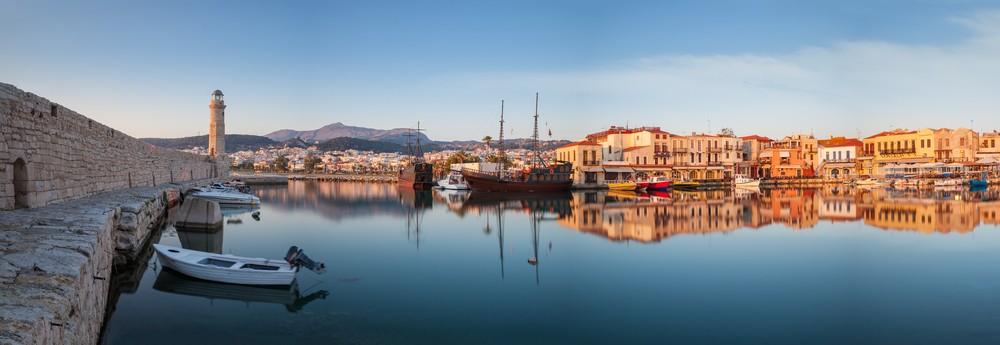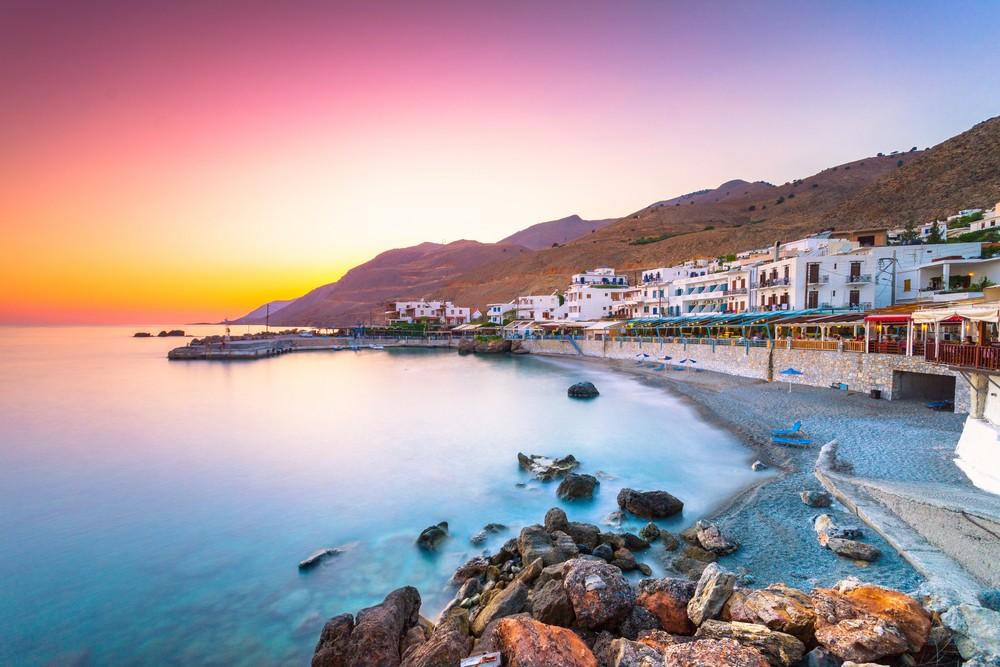Crete is the largest island in Greece with about 8,300 square meters and a popular destination for many vacationers. The island is also considered one of the most beautiful islands and is therefore also called the “Pearl of the Mediterranean”. If you are planning a pure beach holiday in Crete, you will find a turquoise blue sea and countless beautiful sandy beaches on the almost 1,000 km long coast, which invite you to swim, sunbathe and relax. The best time to travel for sun-hungry visitors to the island is the months of June to August.

To discover Crete on your own, a rental car is a good idea. So you don’t have to rely on public buses, which run regularly, but take a very long time to get to the desired sights. The hidden small beaches, bays and rustic taverns are of course much easier to reach by car.
The climate in Crete
The climate in Crete is Mediterranean. However, due to its high mountain ranges, Crete has many different climate zones. The climate therefore differs between the north and south of the island. The high mountains protect the south from clouds and cool currents. The summer in Crete is hot, the winter mild, but also humid. Rain rarely falls in Crete in summer, from June to August it hardly ever rains. Most precipitation falls in the months of November to March. From April to November, the average maximum temperatures are over 20 degrees C.
Beaches in Crete

Whether you are in the Caribbean or Crete – this question arises on the palm beach of Vai in the east of the island. This is where the largest natural palm grove in Europe is located. Unfortunately, the palm grove itself is no longer allowed to be entered, as it has been declared a nature reserve. But there is still a small strip of palm forest on the beach, which definitely evokes a special Caribbean feeling among visitors.
Kiani Akti is a quiet beach west of Kalives. Here the sea is a little colder than normal, as an ice-cold (freshwater) river flows into the sea at this point.
The beach of Elafonisi has a special feature. When there is no wind and the waves are rather calm, the sand on the beach shimmers pink. This colouring of the sand is caused by tiny mussel particles.
But of course, Crete has much more to offer than just great sandy beaches and crystal clear water, because the island is rich in cultural and many other interesting sights.
The wonderful nature of Crete

If you are interested in stalactite caves, you can visit the Meledoni Cave. The 60 mtr. length and 20 mtr. high cave impresses with its stalactites and stalagmites.
Hiking enthusiasts will love the low season in Crete, because then the climate of the island is ideal. Great coastal tours or the breathtaking hike through the 17 km long Samaria Gorge on the south coast are impressive. The Imbros Gorge is also called the little sister of the Samaria Gorge and is only 1.60 mtr. wide. With your arms outstretched, you can easily reach from one rock face to another.
The cave of Psychro, also known as Zeus Cave, is located on the Lassithi Plateau, as is the Kera Kardiotissa Monastery. The Zeus Cave was an important place of worship for the Minoans and was discovered in 1880. The finds that were made here are now spread over many museums around the world. There is a heavenly calm on the Lassithi Plateau, and the view from up there is really worth seeing.
Lefka Ori or the “White Mountains” – this is the name of the largest mountain massif in Crete in terms of area. The Pachnes is at 2,454 mtr. is the highest peak and always captivates many hikers. However, a hike to Lefka Ori is only recommended for experienced hikers. There are some guesthouses or restaurants, but otherwise this region is hardly populated.
The History of Crete

On the south coast of Crete lies the village of Matala, which is known for its beautiful beach and Neolithic caves. As early as the Neolithic Age, the caves were dug into the rock and used as living caves or burial sites. In the 60s, hippies discovered the caves for themselves and settled there. Today, the caves are no longer inhabited, but they are still a special attraction.
Interested visitors can learn something about the past of Crete in the monastery of Arkadi near Rethymnon. The former Orthodox monastery dates back to the 14th century and is the most important national monument in Crete. The 500 mtr. The monastery, which is located above sea level, also offers a wonderful view over the island.
A visit to the coastal city of Chania with its almost 55,000 inhabitants should not be missed on an excursion. While strolling through the Venetian harbor from the 14th century, you can enjoy the gentle sea breeze or visit the many small shops and restaurants in the port district of Splazzia. Also worth seeing are the striking lighthouse at the harbor and the Hasan Pasha Mosque. In the Chania Nautical Museum, the visitor will find everything related to the sea and shipping. A replica Minoan ship can be seen at the other end of the harbor.
Knossos is the most important archaeological site and the largest most famous palace of the Minoan culture. The palace was once the seat of the legendary King Minos. It is located only about 6 km south of Heraklion on the hill Kefala.
Another interesting place is Agios Nikolaos, which is located on the western shore of the Gulf of Mirabello. A visit to the Folklore Museum and the Archaeological Museum is particularly worthwhile.
Flora and fauna in Crete

A special kind of visit for the whole family is offered by the CretAquarium in Heraklion. About 2,000 sea creatures live in 60 different tanks. Ponderous turtles, fearsome sharks, rays or eerie jellyfish make their rounds there. However, the aquarium also takes in sick or injured animals, which are released back into the wild after treatment.
In 2009, the approx. 20 ha botanical garden in Skordalou opened, which was created a few years ago from the ashes of a devastating fire and is now a very special sight in Crete. Visitors can expect endemic plants, cacti, fruit trees, Mediterranean fruits, mountain goats, wild birds, farm animals, butterflies and a small lake.
Cretan cuisine
Greek cuisine was strongly influenced by Turkish and Asia Minor cuisine. If you think that gyros or souvlaki are the most famous dishes of Greek cuisine, you should definitely try the variety of Cretan cuisine.
Yoghurt with walnuts and honey is often offered for breakfast. Other delicacies include octopus in wine sauce, moussaka, fried sardines, musks in broth, rabbit in white wine sauce, sole in tomato sauce, stuffed zucchini flowers, wonderfully fresh tomatoes and cucumbers with hearty sheep’s cheese, plus a delicious bread with olive oil. A meal is often rounded off with a raki or ouzo.
Raki is the Cretan national drink. The high-proof schnapps is obtained from leftovers of pressed grapes. Ouzo is the most famous liquor in Greece and is very popular there and also offered. Ouzo consists of brandy seasoned with anise.
Markets in Crete
The market hall “Agora” is unique in Greece and one of the landmarks of Chania. It is located in the centre of the city and was built according to the model of the Marseille market hall. Fresh fish, meat, spices, fruit, vegetables and souvenirs are offered here. In the market hall there are also nice little restaurants that offer tasty and cheap dishes.
Crete is colorful and diverse – if you have been to Crete once, you will come back again and again!
The most important questions about Crete
When is the best time to travel to Crete?
Due to the high temperatures in midsummer, families with children are particularly recommended for the travel season in April and May (here you can also swim) as well as in the autumn months of September and October.
When does the high season in Crete start?
The bathing season in Crete starts at the end of May and lasts until the end of September. There is a lot of activity, especially in the summer holiday months of July and August.
How long does it take to fly from Germany to Crete?
The flight from Frankfurt to Crete takes just under three hours. From Dusseldorf to Crete the flight time is about 3 hours and 45 minutes. Flight time from Munich to Heraklion is 2 hours and 55 minutes. From Berlin and Hamburg, the flight time is three and a half hours.
Is there a time difference to Crete?
Crete is one hour ahead of the German time. When it is 6:00 p.m., the time on Greece’s largest island is 7:00 p.m.
How big is Crete?
Crete is Greece’s largest island with a total area of 8,336 km².
Können wir Ihnen helfen?
Benötigen Sie Unterstützung bei Ihrer Reiseplanung oder weitergehende Informationen zu einzelnen Reisezielen? Wir freuen uns über Ihre Kontaktaufnahme.


